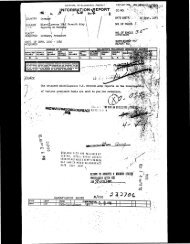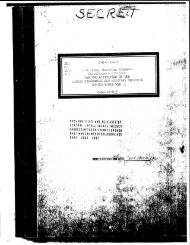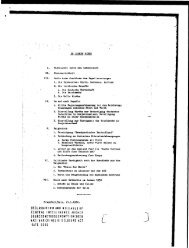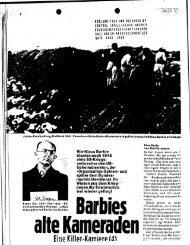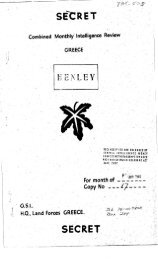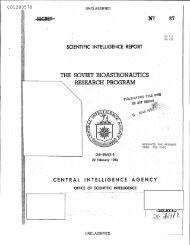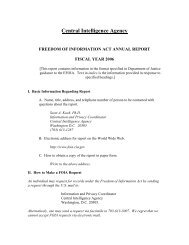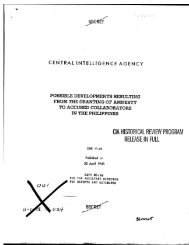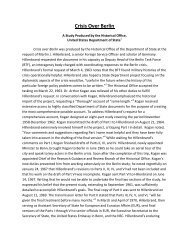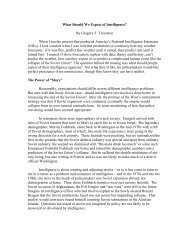The 1983 Soviet War Scare - CIA FOIA - Central Intelligence Agency
The 1983 Soviet War Scare - CIA FOIA - Central Intelligence Agency
The 1983 Soviet War Scare - CIA FOIA - Central Intelligence Agency
You also want an ePaper? Increase the reach of your titles
YUMPU automatically turns print PDFs into web optimized ePapers that Google loves.
<strong>Intelligence</strong> Community as a whole. A<br />
declassified 1984 Special National <strong>Intelligence</strong><br />
Estimate (SNIE), commissioned to assess<br />
indications of an "abnormal <strong>Soviet</strong> fear of<br />
conflict with the United States," was a case in<br />
point.35<br />
<strong>The</strong> SNIE did not refer specifically to RYAN,<br />
although allusions to war-scare statements<br />
suggest some knowledge of the alert. In the<br />
absence of other information, the SNIE<br />
attributed <strong>Soviet</strong> statements to US foreign and<br />
defense policy "challenges"; it attributed recent<br />
<strong>Soviet</strong> military exercises to force development<br />
and training requirements. <strong>The</strong> SNIE played<br />
down the significance of <strong>Soviet</strong> assertions<br />
about US preparations for a surprise nuclear<br />
attack, arguing that the "absence of forcewide<br />
combat readiness and other war preparations<br />
in the USSR" apparently meant that the<br />
Kremlin did not believe war was imminent or<br />
inevitable. 36 <strong>The</strong> "war scare" was more<br />
propaganda than threat perception, according<br />
to this assessment.37<br />
'35 Director of <strong>Central</strong> <strong>Intelligence</strong>, "Implications of Recent<br />
<strong>Soviet</strong> Military-Political Activities," SNIE 11-10-841JX, 18<br />
May 1984 (<strong>CIA</strong> declassified this estimate in early 1996<br />
and released it to the National Archives and Records<br />
Administration )<br />
RAND Corporation expert Jeremy Azrael also<br />
downplayed the significance of the <strong>Soviet</strong> intelligence alert<br />
because it was not accompanied by a military alert or other<br />
military actions He offers Iwo explanations Either <strong>Soviet</strong><br />
leaders believed that the threat of war was higher than<br />
their public statements indicated, or they had ordered the<br />
alert to discredit Cassandras in the high command—<br />
including First Deputy Defense Minister and Chief of the<br />
General Staff Nikolai Ogarkov—by showing that even a<br />
massive indications-and-warning effort could not yield<br />
evidence of US war preparations Azrael leans toward the<br />
former explanation without spelling out his reasons for<br />
doing so—that is, he does not clarify what, if anything,<br />
<strong>Soviet</strong> leaders may have found troubling in US actions<br />
Jeremy R Azrael, <strong>The</strong> <strong>Soviet</strong> Civilian Leadership and the<br />
Military High Command, 1976-1986, R-3521-AF (Santa<br />
Monica, CA <strong>The</strong> RAND Corporation, 1986), p 20, n 32<br />
37 Azrael shares this view, arguing that the war scare was<br />
a "carefully prearranged and closely coordinated<br />
diplomatic script" whose "nice-guy, tough-guy<br />
counterpoint" between top <strong>Soviet</strong> civilian and military<br />
leaders was intended for Western consumption—<br />
specifically, to support the then-current <strong>Soviet</strong> "peace<br />
offensive" aimed at forestalling US intermediate-range<br />
missile deployments in West Germany Ibid , pp v, 30-31<br />
Nonetheless, the SNIE drafters evidently<br />
sensed that there might be more to the story<br />
and raised the possibility that "recent US/<br />
NATO military exercises and reconnaissance<br />
operations" might have been factors in <strong>Soviet</strong><br />
behavior. <strong>The</strong> main clue was the difference<br />
between past and present <strong>Soviet</strong><br />
charactenzations of such exercises and<br />
operations. In the past, Moscow had routinely<br />
cnticized such activities as indications of<br />
Western hostile intentions, but now it was<br />
going considerably further by charging that<br />
they were preparations for a surpnse nuclear<br />
attack. In the final analysis, however, the<br />
SNIE's authors were unable to make a specific<br />
connection between the <strong>Soviet</strong> alert and<br />
Western military moves, noting that a "detailed<br />
examination of simultaneous 'red' and 'blue'<br />
'actions had not been accomplished."38<br />
While the US probes caught the Kremlin by<br />
surpnse, they were not unprecedented; there<br />
was a Cold <strong>War</strong> antecedent. During the 1950s<br />
and 1960s, the US Strategic Air Command and<br />
the Navy had conducted similar operationsintelligence-gathering<br />
missions, including<br />
<strong>The</strong> US <strong>Intelligence</strong> Community remained skeptical<br />
about the strategic warning role of the KGB-GRU alert well<br />
after Gordievsky had defected and been debnefed For<br />
example, Gordievsky recalls meeting a senior US expert<br />
on <strong>Soviet</strong> affairs in Washington who appeared quite<br />
knowledgeable about the alert but "cast doubt on all my<br />
information about Operation RYAN His theory was that<br />
the whole thing had been no more than a deception<br />
exercise by the <strong>Soviet</strong> leadership " See Oleg Gordievsky,<br />
Next Stop Execution <strong>The</strong> Autobiography of Oleg<br />
Gordievsky (New York Macmillan, 1995), p 377 A US<br />
diplomatic correspondent notes that such skepticism was<br />
rather widespread<br />
Many senior administration officials scoff now, as<br />
they did then, at the suggestion that the <strong>Soviet</strong><br />
Union was genuinely alarmed by U S military<br />
moves or public statements, or that Moscow had<br />
any justification for feeling vulnerable <strong>The</strong> 'war<br />
scare' in the <strong>Soviet</strong> Union in 1982-<strong>1983</strong> was<br />
deliberately engineered for propaganda purposes,<br />
these officials maintain—a pretext to create siege<br />
mentality in the <strong>Soviet</strong> Union, and to fnghten the<br />
outside world about U S intentions (Murray<br />
Marder, "Defector Told of <strong>Soviet</strong> Alert, KGB Station<br />
Reportedly <strong>War</strong>ned U S Would Attack,"<br />
Washington Post, August 8, 1986, p Al)<br />
Moscow . . .<br />
was going<br />
considerably<br />
further (than<br />
before] by<br />
charging that<br />
(US/NATO<br />
exercises and<br />
reconnaissance<br />
operations]<br />
were<br />
preparations<br />
for a surprise<br />
nuclear attack.<br />
11



